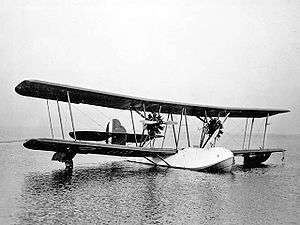Canadian Vickers Varuna
The Canadian Vickers Varuna was a Canadian flying boat of the 1920s built by Canadian Vickers as a twin-engined, unequal-span biplane, with a wooden hull and steel tube structure.
| Varuna | |
|---|---|
 | |
| Role | Transport flying-boat |
| Manufacturer | Canadian Vickers |
| Retired | 1932 |
| Status | out of service |
| Primary user | Royal Canadian Air Force |
| Number built | 8 |
| Developed from | Canadian Vickers Vedette |
Design and development
The Varuna was developed in response to a Royal Canadian Air Force requirement for a flying boat to transport men and equipment to forest fires. It was a large-scale twin-engined version of the Vedette.
Operational history
Most Varunas spent their service in Manitoba operating in their intended role; all Varuna IIs were withdrawn in 1930 and the sole Varuna I was struck off in 1932
Variants
- Varuna I - with Wright J-6 Whirlwind radial engines, one built.
- Varuna II - with Armstrong Siddeley Lynx IV radial engines.
Specifications (Varuna II)
Data from Jane's all the World's Aircraft 1928[1]
General characteristics
- Crew: 4
- Length: 36 ft 10 in (11.23 m)
- Upper wingspan: 55 ft 1 in (16.8 m)
- Lower wingspan: 47 ft 4 in (14.42 m)
- Height: 13 ft 9 in (4.19 m)
- Wing area: 715 sq ft (66.4 m2)
- Empty weight: 3,369 lb (1,528 kg)
- Gross weight: 5,299 lb (2,404 kg)
- Fuel capacity: 90 imp gal (110 US gal; 410 l) in two wing tanks, with an optional 60 imp gal (72 US gal; 270 l) ferry tank in the hull
- Powerplant: 2 × Armstrong Siddeley Lynx IV 7-cyl. air-cooled radial piston engine, 187 hp (139 kW) each
Performance
- Maximum speed: 82 kn (94 mph, 151 km/h)
- Alighting speed: 44 mph (38 kn; 71 km/h)
- Service ceiling: 14,000 ft (4,300 m)
- Time to altitude: 5,000 ft (1,500 m) in 9 minutes
- Wing loading: 7.4 lb/sq ft (36 kg/m2)
- Power/mass: 0.0377 hp/lb (0.0620 kW/kg)
gollark: osmarks.tk primary server™ has about 800GB free and I have basically nothing to use that for...
gollark: How big is this fanfiction dataset?
gollark: I see.
gollark: Maybe you should have a search index or something? How much storage do you have?
gollark: Did you finish all the "MENACE" challenges?
References
- Grey, C.G., ed. (1928). Jane's all the World's Aircraft 1928. London: Sampson Low, Marston & company, ltd. pp. 69c–70c.
| Wikimedia Commons has media related to Canadian Vickers Varuna. |
This article is issued from Wikipedia. The text is licensed under Creative Commons - Attribution - Sharealike. Additional terms may apply for the media files.